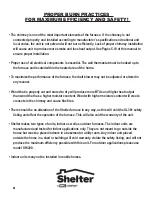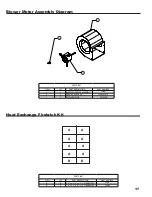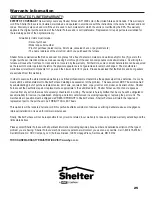
NEVER operate the furnace with the fuel door or ash door open!
NEVER operate the furnace with the ash pan left inside of the unit!
First Fire:
Set the wall thermostat to 90°F.
Place several crumpled newspapers on the grate with some dry kindling layered on top of the papers, then ignite the newspaper
and close the fuel door. After approximately 5 minutes, open the fuel door, add several small pieces of wood and then close the
door. After about 20 minutes the fire should be established, allowing you to load the firebox and set the wall thermostat to the
desired home temperature.
Do not over-fire the furnace.
Over-firing by overloading/over-fueling the furnace causes the metal to superheat and expand, then cool
rapidly, which causes cracking, therefore voiding the warranty. Over-firing, or abuse, can easily be determined upon inspection.
The ash pan must remain out of furnace during operation.
NOTE:
Your new Shelter Furnace is capable of producing a very high BTU output. Do not fuel your furnace to capacity upon initial firing.
It’s recommended that you become thoroughly familiar with your Shelter Furnace before operating at full capacity.
The new steel and metal components of the furnace have a protective coating of paint on the surface which could produce an odor during
the break in period. Adequate ventilation within the home and furnace room or area is recommended during the initial firing and break in
period to accommodate this possibility. Your new Shelter Furnace is classified as having airtight construction. This type of design should
enable you to experience up to 12 hours of burn time per full load of fuel (
dry, seasoned hardwood
). However, abnormally cold weather
may reduce the burn time somewhat, but if your burn cycle is significantly less (for instance 2 to 4 hours), this type of occurrence is usually
symptomatic of heat demands in excess of furnace capacity. Contact an authorized professional to determine if your Shelter Furnace has
been improperly sized for your home. The heat output range, according to B415.1-10 testing, is 18,000 to 45,000 BTUs per hour.
Loading Wood:
When opening the fuel door during operation, always wait 10 seconds after releasing the first latch, then open the door the rest of the way.
The dual latch system has been incorporated as a safety feature, designed to eliminate the possibility of gaseous ignition. Laboratory
testing has determined that when incomplete combustion occurs the partially spent fuel sometimes concentrates large amounts of
potentially hazardous gases within the fire chamber. If the door is opened suddenly under these conditions, the oxygen may combine with
these gases and cause ignition referred to as “back flash.” Use EXTREME CAUTION when opening the fuel door.
When reloading the furnace, spread embers evenly over the grate. Place smaller pieces of wood on the hot embers and layer larger pieces
on top of them.
Finally, due to the wide variety of temperature ranges during the winter, you may experience periods when it is
not necessary to fully load the fire chamber in order to maintain an overnight burn.
Your Shelter Furnace will operate at the highest
efficiency by adding fuel in amounts needed to maintain comfortable temperatures in your home.
BURN WOOD ONLY!
Disposal of Ashes:
Heat resistant gloves are recommended. In order to remove ashes from your Shelter Furnace, open the ash door and slide the ash pan to
the rear of the furnace. Remove the ash pan from the furnace and dump the ashes into a metal container with a tight fitting lid. The closed
container of ashes should be placed on a non-combustible floor or on the ground, well away from all combustible materials, pending final
disposal. If the ashes are disposed of by burial in soil or otherwise locally dispersed, they should be retained in the closed metal container
until all cinders have thoroughly cooled.
The ash pan must be removed from your Shelter Furnace during operation. This precautionary measure is recommended
13














































